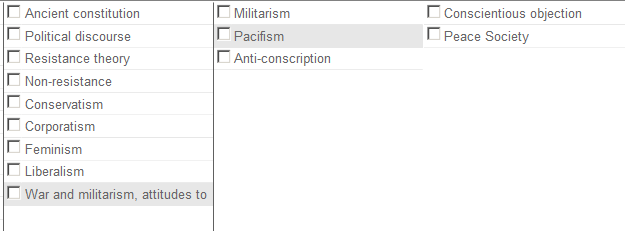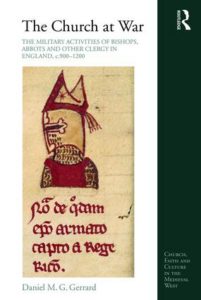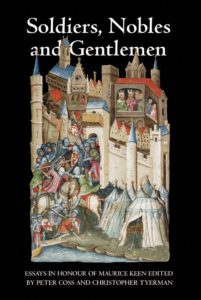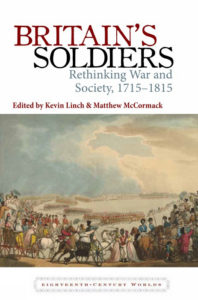With the ending of the Radical Voices exhibition at Senate House, the People Power: Fighting for Peace exhibition at the IWM about to begin, and the re-opening of the National Army Museum, it seems like an appropriate time to look at war in BBIH.
In the Subject tree, “War and militarism, attitudes to” is the broad term which includes, as lower terms, Militarism, Pacifism, and Anti-conscription, while Pacifism itself is a broader term for Conscientious objection and Peace Society. Thus searching for “War and militarism, attitudes to” will bring up all of these terms.

Taking a chronological approach and beginning with Anglo-Saxon England we kick off with Looking back in Anger: Wrath in Anglo-Saxon England. This article not only examines the emotion of anger using the Old English language anger vocabulary, but also looks at how religious conversion brought new attitudes to the emotional response to war, especially to an Anglo-Saxon warrior culture, where anger played a role in constructing a man’s honour and helped him excel in battle. The article uses quotes from the poem the Battle of Maldon.
Religious responses to warfare are also discussed in An Abbot, an Archbishop and the Viking Raids of 1006-7 and 1009-12 which uses Ælfric, abbot of Eynsham, and Wulfstan, archbishop of York reflections, prayer and representation in the coinage and in charter evidence. The Viking raids of 1006 are further explored in Landscape and Warfare in Anglo-Saxon England and the Viking Campaign of 1006 . This argues that certain types of place were considered particularly appropriate for the performance of violent conflict throughout this period and that these locales are recoverable through an interdisciplinary analysis of landscapes, place names and texts.
The themes of the religious response to warfare and the role of masculinity are continued in the Warrior Churchmen of Medieval England, 1000-1250 : Theory and Reality which looks at the role of Odo Bishop of Bayeux and earl of Kent, and Geoffrey bishop of Coutances. This theme is continued in the recent book, The church at war : the military activities of bishops, abbots, and other clergy in England, c.900-1200.

Covering the later medieval period we start with The Hundred Years War in literature, 1337-1600 which charts the narration of the war in English literature, from contemporary chroniclers and poets, such as Chaucer and Lydgate, to later polemicists and playwrights looking back on their medieval past. The book also includes the dramas of Shakespeare as well as anonymous chroniclers, balladeers and agonising eyewitness accounts of warfare.
The collective volume, Emotions and War : Medieval to Romantic Literature, includes the following medieval chapters, Emotional Responses to Medieval Warfare in the History of William Marshal, and Moving to War: Rhetoric and Emotion in William Worcester’s Boke of Noblesse. Another chapter moves on to the later period: ‘I was enforced to become an eyed witnes’ : Documenting War in Medieval and Early Modern Literature, while others cover the British civil wars, the American Revolution in North Carolina, and Henry Crabb Robinson’s Letters to The Times, 1808–9 covering the Peninsular Wars.
The conflict between war and religious thought continues during the later medieval period and the Lollard view of the just war is discussed in John Wyclif on War and Peace which includes a chapter entitled, The Medieval Pacifist.
Increasingly, as one may expect, the role of chivalry comes to the fore. There is Chivalry, War and Clerical Identity : England and Normandy c. 1056-1226 in Ecclesia et Violentia : Violence Against the Church and Violence within the Church in the Middle Ages which also harks back to the involvement of the clergy; and English Writings on Chivalry and Warfare during the Hundred Years War in Soldiers, nobles and gentlemen : essays in honour of Maurice Keen.

For the early modern period we have Trauma Narratives of the English Civil War which explores the psychological impact and after effects of the war. Its main points of focus are the expressions of personal as well as collective trauma caused by this conflict. In this context, the discussion places the ways in which war experiences were narrated in relation to wider conceptualizations of traumatic damage to the mind.
The chapter Early Modern War Writing and the British Civil Wars discusses the growth of martial writing in the 16th and 17th centuries and, of course covers the Civil War. It charts the classical influences and the use of eyewitness accounts and the use of powerful language reflecting strong military command. This aspect of language is also explored in the chapter, ‘Broken Verses across a Bloodied Land’ : Violence and the Limits of Language in the English Civil War (in Aspects of Violence in Renaissance Europe).

In addition, there is Parliamentary Politics and the Politics of the Street : The London Peace Campaigns of 1642-3 which argues that Londoners were more lukewarm towards parliament and its campaign than received accounts would lead us to believe. After the battle of Edgehill people quickly lost their appetite for further conflict and an increasingly large minority campaigned actively for peace.
The role of the Quakers is also highlighted in the chapter, The “Lamb’s war” and the origins of the Quaker peace testimony, contained in The pacifist impulse in historical perspective, as well as the article The Early Quakers, the Peace Testimony and Masculinity in England, 1660–1720. The latter considers the Friends’ pacifism and its relation to masculinity, including its relation to Quaker rejections of domestic violence and to the violence of the alehouses. The article also highlights how seventeenth- and twentieth-century interpretations of pacifism differed.
Of course Quakerism, and other non-conformists, are associated with the conscientious objectors of World War I. But let’s not get ahead of ourselves, for the 18th and 19th century and more especially the Napoleonic Wars are also covered in the article Christian heroes, providence, and patriotism in wartime Britain, 1793–1815. Evangelicals sought to resolve tensions between heroism, virtue, masculinity, religiosity and war by advancing a different set of ideals, a difficult task in a highly charged patriotic society. A less salubrious view of the military is explored in Scarlet Fever: Female Enthusiasm for Men in Uniform, 1780-1815 in Britain’s Soldiers : Rethinking War and Society, 1715-1815 which outlines a ‘dangerous disorder prevalent in wartime’, principally afflicting women.

Of course much of our view of attitudes to war is coloured by World War I and the conscientious objector. With over a thousand references it is hard to pick out a couple of books or articles. However, taking us to the most recent wars we have Going to War : British Debates from Wilberforce to Blair and The March that Shook Blair : An Oral History of 15 February 2003. The march and reactions to it are further explored in Local Press Reporting of Opposition to the 2003 Iraq War in the UK and the Case for Reconceptualizing Notions of Legitimacy and Deviance. The parliamentary ramifications are also deliberated in Challenging the Royal Prerogative : The Decision on War against Iraq in Parliamentary Debates in 2002–3.
The above is simply an outline of references available on BBIH – that’s without exploring specific wars, civil-military relations, the Campaign for Nuclear Disarmament or the Greenham Common peace activists.
